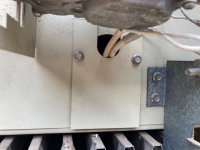danpik said:Pull both wires and insert a jumper wire to connect them together. May or may not work as some boards now have logic to ensure you can't do this.petes914 said:How do I jump out the Pressure switch? if I remember correctly, there are two spade terminals on the pressure switch, one NC and the other O.
No, that is why the ceramic insulator is there. The current flow (electricity) comes from the board, up the wire to the probe and grounds thru the flame to the burners.petes914 said:Also, is the screw holding in the flame sensor the ground for it? I didn't make any effort to wire wheel any corrosion when I installed the new flame sensor.
I plagerized this from another site to hopefully help you understand how this works.
The method used to prove flame in most gas-fired products produced in the last seven or eight years is often misunderstood. This method is usually known as “flame rectification.”
Many servicers believe the flame sensor takes an active role in proving flame, and because of this, believe the sensors sometimes fail. Let’s look at what happens.
In order to verify flame, the ignition control must establish current flow using the flame as a conductor.
The mechanics of flame sensing
When everything is working right, the moment flame touches the sensor, the module establishes and monitors this current flow.
The voltage at the sensor is ac (alternating current), but because of the great difference in mass between the flame sensor and the furnace chassis, this voltage is “rectified” from ac to dc (direct current), usually less than 10 microamps.
As long as this current flow exists, the ignition control will power the gas valve.
The flame sensor is not sensing anything. The flame sensor’s only “claim to fame” is that it is resistant to the effects of being immersed in flame.
A flame sensor can become coated with a silica-type material. (Silica is a component of glass and glass is a great insulator.) When this happens, all that is required is a cleaning of the sensor with a light abrasive.
That’s the mechanical side. Now let’s look at what can go wrong electrically.
Electrical snafus
We know that 115 vac has one hot leg and one neutral. The black (or common) leg has the potential to ground. The neutral does not.
Apply this to what we just learned about flame sensing and think about what will happen if a furnace is installed with the neutral and common reversed.
The module must establish current flow through the flame to ground, right? So if the black and white are switched in the junction box or the receptacle, there is no flame sense because there is no voltage potential.
Everything else in the unit works fine, but a few seconds after the burners light . . . the module closes the gas valve because the power for the flame-proving circuit is not there.
What if the common and neutral are connected properly, but the flame still drops out for “no reason?”
Check the ground to the unit. Here’s how:
You have already measured between common (black) and ground and read 120 vac. Now measure between neutral (white) and ground to be sure you have no voltage (0.0 vac).
Remember, your flame-sense current is very small, usually less than 10 microamps dc. Think about what would happen to the flame-sense current if there were another voltage potential at the furnace chassis because of a poor ground.
The ignition control needs a clean, properly polarized voltage source to do its job.
Thanks Dan. I'm going to check this all out tonight.


